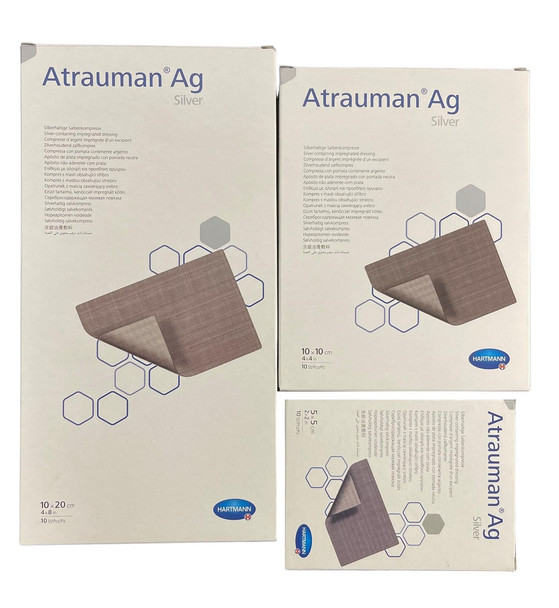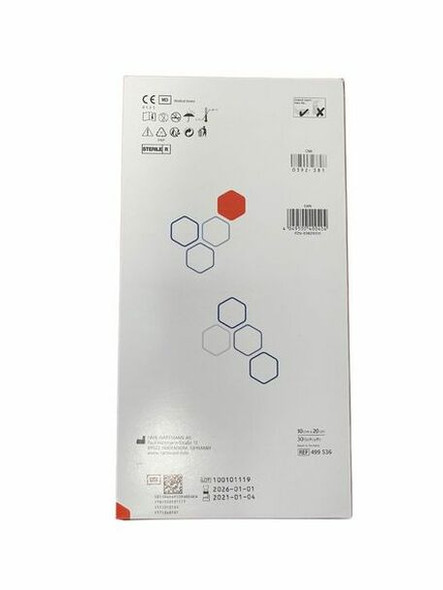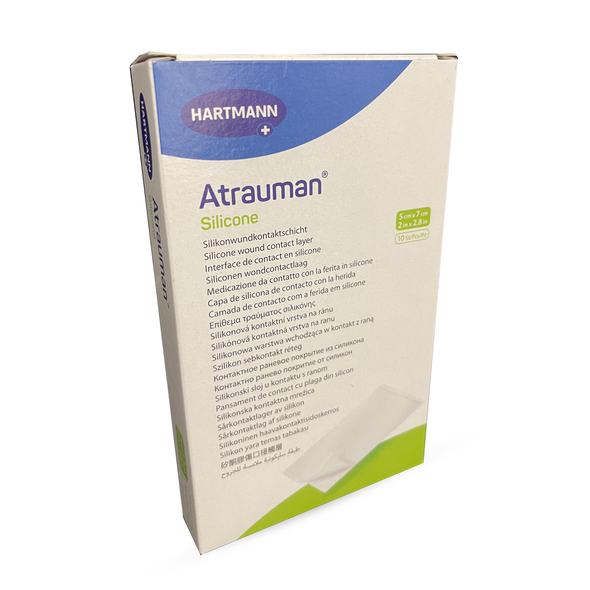Description
Atrauman Ag is a non-adherent wound contact layer suitable for the treatment of chronic wounds, such as ulcus cruris, diabetic leg ulcer and decubitus. It is also suitable for the treatment of acute burns up to 2nd degree. Atrauman Ag is suitable for the treatment on the human skin by professional users. The support fabric is made of polyamide fibers coated with elemental silver. The impregnation is non-medicated and triglyceride based (neutral lipids). The impregnation contains (INCI assigned names): Caprylic/Capric/Myristik/StearicTriglyceride; Bis-diglycerylpolyacyladipate-2 and Macrogol 2000. The soft, thin support fabric drapes easily and ensures close contact with the wound base. The fabric’s surface and the impregnation counteract adhesion to the wound; as a result, the dressing supports atraumatic dressing changes. Atrauman Ag acts as a silver-containing barrier dressing. The impregnation protects the wound edges helping to prevent maceration, it is non-medicated and contains no paraffin.
Benefits & Features
- Thin, soft , drapable
- Can be cut into your preferred size
- Ensures close contact with the whole surface of the wound
- Supports painless dressing change by minimizing adhesion to wounds
- Suitable for treatment of chronic wounds
- Suitable for treatment of acute burns up to 2nd degree
- Made from polyamide fibers coated with elemental silver
- Non-medicated
- Prevents maceration
- Non-adherent
- Available in a range of sizes
Instructions For Use
- Take the Atrauman Ag from the peel pack with both cover papers in place and, if necessary, cut it so that it fits the size of the wound by applying sterile conditions. Atrauman Ag should overlap the wound and should be about the same size as the secondary dressing.
- Remove the cover paper on one side. Either place the free side on the wound and then remove the remaining cover paper or use sterile tweezers or sterile gloves to pick up Atrauman Ag from the second cover paper and place it on the wound
- Atrauman Ag should be applied in a single layer, not fold or apply in multiple layers.
- Secure a suitable sterile, secondary dressing (either absorbent or superabsorbent dressings, foam dressings or gauzes e.g. Zetuvit Plus) according to its use instructions over Atrauman Ag to absorb wound exudate.
- The efficacy of the barrier dressing lasts for up to seven days. Unless otherwise prescribed by the doctor or medically indicated, a new Atrauman Ag dressing should be applied at each dressing change. The wear time of one dressing shall not exceed seven days.
FAQ
Atrauman is a brand name for a type of wound dressing used in medical practice. It is a hydrocolloid dressing that is commonly used for the management of partial and full-thickness wounds, such as pressure ulcers, leg ulcers, and surgical wounds.
Atrauman dressing works by creating a moist environment around the wound, which helps to facilitate the healing process. The hydrocolloid material in the dressing helps to absorb exudate (fluid) from the wound, keeping it moist and preventing the formation of scabs. This moist environment can help to reduce pain, promote the growth of new tissue, and reduce the risk of infection.
In summary, Atrauman dressing is a wound care product used to manage various types of wounds and to promote the healing process by creating a moist environment around the wound.
The frequency of changing an Atrauman dressing depends on several factors, such as the type and severity of the wound, the amount of exudate produced, and the overall condition of the wound.
In general, Atrauman dressing should be changed every 3 to 5 days or as needed, based on the condition of the wound and the dressing. If the dressing becomes wet or saturated with exudate, it should be changed immediately to prevent skin maceration (over-hydration) and to maintain an optimal healing environment for the wound.
It is important to note that the frequency of dressing changes should be determined by a healthcare professional, such as a nurse or doctor, who can assess the wound and make recommendations based on the patient's individual needs.
In any case, it is recommended to follow the instructions of a healthcare professional and to avoid changing the dressing too frequently, as this can disrupt the healing process and increase the risk of infection.
The best dressing for an ulcer depends on several factors, including the type, location, and severity of the ulcer, as well as the patient's individual needs and preferences. Some commonly used wound dressings for ulcers include:
- Hydrocolloid dressings: These dressings are made of a gel-like material that absorbs exudate and creates a moist environment around the wound, which can promote healing. Hydrocolloid dressings are commonly used for partial-thickness and full-thickness wounds, including pressure ulcers and leg ulcers.
- Foam dressings: Foam dressings are made of a soft, spongy material that can absorb exudate and cushion the wound. They are commonly used for pressure ulcers, leg ulcers, and other types of wounds.
- Alginate dressings: Alginate dressings are made of a natural material derived from seaweed and are designed to absorb exudate and create a moist environment around the wound. They are commonly used for leg ulcers, pressure ulcers, and other types of wounds that produce a lot of exudate.
- Hydrogel dressings: Hydrogel dressings are made of a gel-like material that helps to soothe and hydrate the wound. They are commonly used for superficial wounds, such as minor cuts and burns, and can help to reduce pain and promote healing.
- Film dressings: Film dressings are made of a thin, transparent material that helps to protect the wound from external contaminants. They are commonly used for superficial wounds, such as minor cuts and abrasions, and can help to reduce pain and promote healing.
It is important to note that the best dressing for an ulcer should be determined by a healthcare professional, such as a nurse or doctor, who can assess the wound and make recommendations based on the patient's individual needs. In some cases, a combination of dressings may be used, depending on the specific needs of the patient and the stage of wound healing.
Atrauman and Zetuvit are both brands of wound dressings used in medical practice. While they share some similarities, there are also some differences between the two.
Atrauman is a hydrocolloid dressing that is commonly used for the management of partial and full-thickness wounds, such as pressure ulcers, leg ulcers, and surgical wounds. It works by creating a moist environment around the wound, which helps to facilitate the healing process. The hydrocolloid material in the dressing helps to absorb exudate (fluid) from the wound, keeping it moist and preventing the formation of scabs.
Zetuvit is a brand of wound dressing that offers a range of products for different wound care needs. Some Zetuvit dressings are made of a combination of materials, including hydrocolloids, foam, and alginate, which can provide multiple benefits for wound care. For example, Zetuvit Plus is a hydrocolloid dressing that combines hydrocolloid and foam materials to provide both moisture management and cushioning.
In summary, Atrauman and Zetuvit are both wound dressings that can be used to manage various types of wounds, but they are different in terms of their composition and the specific benefits they provide. The best dressing for a particular wound should be determined by a healthcare professional, who can assess the wound and make recommendations based on the patient's individual needs.



































